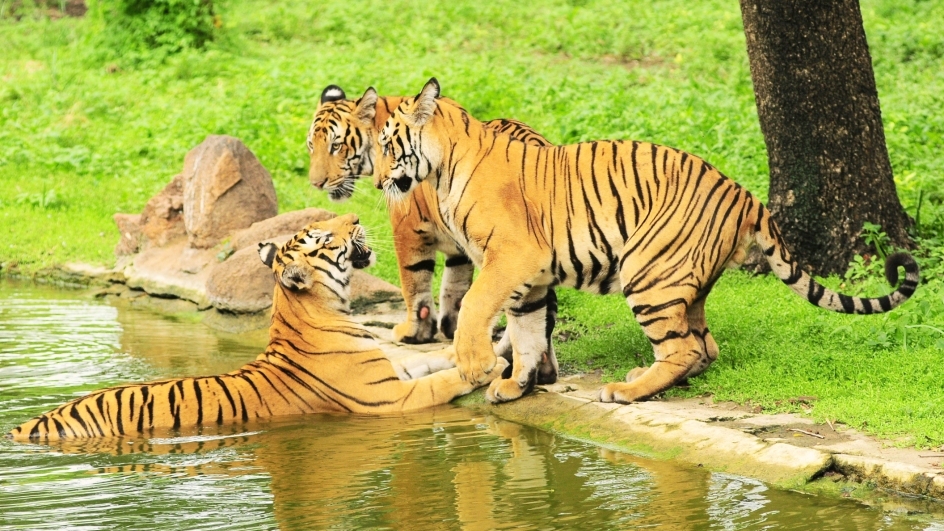#InternationalTigerDay: Fascinating Facts About the Biggest Wild Cats
#DidYouKnow: The newborn cubs can’t see
For more such trivia click here: weather.com/en-IN/india/en…
#GlobalTigerDay
#DidYouKnow: The newborn cubs can’t see
For more such trivia click here: weather.com/en-IN/india/en…
#GlobalTigerDay

Tigers have dominated the wild ecosystems in India for hundreds of thousands of years. The earliest remains of tiger fossils date back to more than two million years ago. These beautiful beasts have evolved to swim.
#TigerDay
(📸:Ramoorthy P/TOI, Hyderabad, BCCL)
#TigerDay
(📸:Ramoorthy P/TOI, Hyderabad, BCCL)

These wild cats play an important role in balancing several ecosystems, and therefore, their conservation has always been of prime importance across the world. It is said in the 1900s, around 100,000 tigers roamed worldwide.
#InternationalTigerDay2020 #InternationalTigerDay
#InternationalTigerDay2020 #InternationalTigerDay
But in recent decades, much of the wild tiger population rapidly declined due to hunting and habitat loss.
#InternationalTigerDay2020 #InternationalTigerDay #TigerDay
#InternationalTigerDay2020 #InternationalTigerDay #TigerDay
Earlier, there existed about nine subspecies of tigers, but now, only six of them are present on Earth—the Bengal tiger, South China tiger, Indochinese tiger, Sumatran tiger, and the Siberian tiger.
The #BengalTiger accounts for the highest numbers, forming 50% of the total tiger population worldwide. The Royal Bengal tiger weighs about 330 kgs, while the Siberian tiger is about 13 feet long and weighs 660 pounds, which is equivalent to roughly 300 kgs.
(📸:BCCL, Mysuru)
(📸:BCCL, Mysuru)

The Sumatran tiger is said to be the smallest among these subspecies, weighing up to 310 pounds (140 kgs).
#InternationalTigerDay2020 #InternationalTigerDay #TigerDay
#InternationalTigerDay2020 #InternationalTigerDay #TigerDay
On the occasion of #InternationalTigerDay, which is celebrated every year on July 29, The Weather Channel brings to you some of the most amazing facts about these big wild cats.
#InternationalTigerDay2020
#InternationalTigerDay2020
Tiger stripes are unique—like human fingerprints
Tigerskin is extremely unique and was among the highly valued trade commodity in the 19th century due to the bold patterns of stripes on the animal’s body.
#InternationalTigerDay2020 #TigerDay
(📸: Madhusudan/TOI, Mysuru/BCCL)
Tigerskin is extremely unique and was among the highly valued trade commodity in the 19th century due to the bold patterns of stripes on the animal’s body.
#InternationalTigerDay2020 #TigerDay
(📸: Madhusudan/TOI, Mysuru/BCCL)

Tigerskin displays mainly two colours—black and orange, derived from pigments eumelanin and pheomelanin, respectively. The production of the orange colour is caused by the gene SLC45A2.
#InternationalTigerDay2020 #InternationalTigerDay #TigerDay
#InternationalTigerDay2020 #InternationalTigerDay #TigerDay
The stripe patterns are unique to each wild cat. And that is how surveyors distinguish between two different tigers during the census. The gorgeous stripes run across the width of their body, and it is not just fur which displays this stripe feature, but the tiger’s skin as well.
Tigers have webbed toes
Unlike most cats, tigers love swimming and playing in the water. In fact, such is their love for water that they seem to have adopted a semi-aquatic lifestyle by living around the water bodies.
#InternationalTigerDay2020 #InternationalTigerDay #TigerDay
Unlike most cats, tigers love swimming and playing in the water. In fact, such is their love for water that they seem to have adopted a semi-aquatic lifestyle by living around the water bodies.
#InternationalTigerDay2020 #InternationalTigerDay #TigerDay
They have been observed to enjoy staying in water for longer durations, and are excellent swimmers. This in-built talent is enabled by their webbed toes, which makes it easy for them to push a greater volume of water.
A surprising fact about these apex predators is that they can easily swim across rivers at a stretch several kilometres.
#InternationalTigerDay2020 #InternationalTigerDay #TigerDay
#InternationalTigerDay2020 #InternationalTigerDay #TigerDay
The newborn cubs can’t see
The tiger cubs are born blind, and they only open their eyes six to twelve days after their birth. Even after that, they do not get their complete vision for at least another couple of weeks.
The tiger cubs are born blind, and they only open their eyes six to twelve days after their birth. Even after that, they do not get their complete vision for at least another couple of weeks.
During these initial days, the cubs only follow the scent of their mother and are completely dependent on her for food and protection. They continue to tag around their mothers until they are about 24 weeks old.
#InternationalTigerDay2020 #InternationalTigerDay #TigerDay
#InternationalTigerDay2020 #InternationalTigerDay #TigerDay
Their roars are LOUD!
A tiger’s roar is so loud that it can be heard from as far as three kilometres away. Moreover, one of the scientific studies revealed, the roar can also paralyze the other animals, especially some of its prey.
#InternationalTigerDay2020 #TigerDay
A tiger’s roar is so loud that it can be heard from as far as three kilometres away. Moreover, one of the scientific studies revealed, the roar can also paralyze the other animals, especially some of its prey.
#InternationalTigerDay2020 #TigerDay
The main vocalisations of a tiger include roaring, growling, hissing, moaning, and chuffing. This majestic creature’s vocal chord is built in the shape of a square, which allows tigers to be extra loud. Their roars can go up to 114 decibels, as deafening as the jet engine.
#Tigers can imitate other animals for prey
The wild cats can easily mimic the call of other animals, this helps to successfully attract prey. Usually, they create a ‘pook’ sound of bears, thus creating a good trap.
#InternationalTigerDay2020 #InternationalTigerDay #TigerDay
The wild cats can easily mimic the call of other animals, this helps to successfully attract prey. Usually, they create a ‘pook’ sound of bears, thus creating a good trap.
#InternationalTigerDay2020 #InternationalTigerDay #TigerDay
• • •
Missing some Tweet in this thread? You can try to
force a refresh














